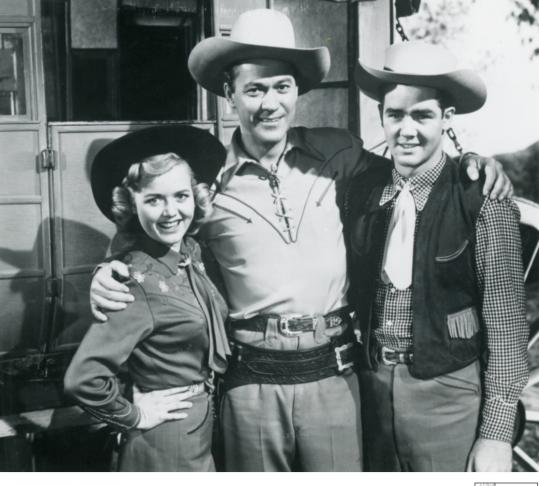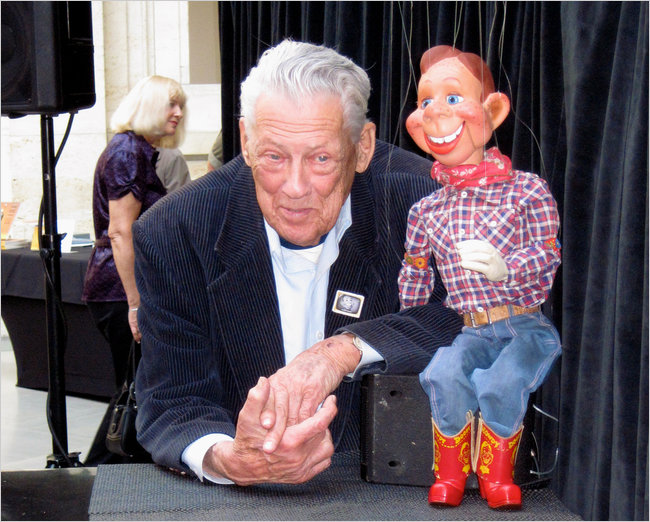Gloria Winters (left) as Penny, with her Sky King colleagues, Kirby Grant (center) in the title role of Schuyler ‘Sky’ King, and Ron Hagerthy.Come Fly With Her
As Sky King’s Penny, Gloria Winters was an early female role modelGLORIA WINTERS
November 28, 1931 (1932?)-August 14, 2010On a Saturday morning schedule crowded with wonderful kids’ shows, Sky King, starring Kirby Grant, stood out as a mold breaking entry in television’s first generation productions. As rancher Schuyler “Sky” King, Grant’s character was called upon by his friend Mitch, the local sheriff, to use his small airplane to help the police solve a mystery or capture a bad guy. Sky King stood alone as a modern-day Western, a show set in the wide open spaces of the west but unquestionably modern in attitude, atmosphere and style, a show in which each logic and investigation ruled the day instead of gunplay. Well written and well played, it boasted, in the character of Penny, “Sky” King’s niece, an early model of feminine backbone and smarts. Played to spunky, sassy perfection by Gloria Winters, Penny not only held her own intellectually with the big boys around her—with wit being a weapon she brandished with relish—but she was very nearly King’s equal as a pilot. Everything about Penny bespoke a confident female who ceded nothing to the male of the species, yet was perky and polite, reveling in her exuberant youth. Winters played Penny through the entire Sky King run, 1951 to 1959, then retired from show business. In 1963 she was back in the public eye as an author of Penny’s Guide to Teen-Age Charm and Popularity, a book on etiquette for girls.
A tribute to Gloria Winters posted on YouTube by skynpenny, with scenes from Sky KingOn August 14, Gloria Winters passed away at her home in Vista, CA, from complications of pneumonia. Born in Los Angeles on November 28 (the year has been reported as both 1931 and 1932), Winters broke into show business a child actor, with uncredited roles in the movies Luxury Liner (1948) and El Pas (1950). Her television debut was as Babs, the swooning teenage daughter in the first season of The Life of Riley, when the working class title character—who worked in an airplane factory, in fact—was portrayed by Jackie Gleason before it was taken over by William "What a revoltin' development this is" Bendix. She became an in-demand supporting actor in the nascent medium of television, logging guest appearances on The Lone Ranger, Richard Diamond Private Detective, The Life and Legend of Wyatt Earp, The Gene Autry Show, The Range Rider, Rocket Squad, Death Valley Days and Studio 57. Her film credits included Hot Rod (1950), Gambling House (1951), Hold That Line (1952) and Geraldine (1953).
A scene from a Sky King episode originally broadcast April 30,1956. Someone has sabotaged a young rancher’s harvest by putting weed killer in the crop duster plane.Sky is off to confirm his suspicions, and relies on Penny to take swift action once he gets confirmation of what’s going on.She was married to Dean Vernon, a sound engineer she met on the Sky King set. He died in 2001. She had no reported survivors.
Her 1963 book had a second life in the mid-‘90s when the alternative rock bang Nada Surf used text from it for its song and video “Popular.” Ms. Winters’s most quoted piece of advice? “Being attractive is the most important thing there is.”
Nada Surf, ‘Popular,’ lyrics in part drawn from Gloria Winters’s 1963 book, Penny’s Guide to Teen-Age Charm and Popularity***
Edward Kean with his friend Howdy DoodyDoes Anybody Really Know What Time It Is?
Edward Kean
October 28, 1924-August 13, 2010Being a behind-the-scenes kind of guy, Edward Kean was not nearly as well known to young TV viewers of the ‘50s as was Sky King’s Gloria Winters (Penny, on the show), but, thanks to Bart Simpson, his words—or at least one word, “Cowabunga!”—live on. As the “chief writer, philosopher and theoretician” of The Howdy Doody Show, as author Stephen Davis put it in his history of the show, Say Kids! What Time Is It? (Little Brown, 1987), Kean loomed large over Howdy’s success. According to Davis, Kean wrote “almost every line spoken and every note sung” on the show, and in addition developed the story lines and even some of the characters that became beloved by a generation. With show host Buffalo Bob Smith Kean co-wrote the show’s theme song, “It’s Howdy Doody Time,” appropriating the melody from the rousing “Ta-Ra-Ra-Boom-De-A,” and on his own dreamed up some of Howdy’s most memorable friends, such as the curmudgeonly Phineas T. Bluster and his dim-witted go-fer, Dilly Dally, and coined names for Clarabell the Clown, Flub-a-Dub and the sexy Princess Summerfall Winterspring. He came up with “Cowabunga!” as a surprised expression to be uttered by Chief Thundercloud (Kean spelled it “kowabunga”). He claimed he had tried to have his telephone number listed as Cowabunga Kean, but was turned down.
The Howdy Doody Show, opening sequence, theme song and Rice Krispies commercial: ‘That-a boy, Howdy.’In toto, Kean wrote more than 2,000 episodes of The Howdy Doody Show, beginning with its original incarnation as a one-hour Saturday program called Puppet Playhouse on NBC on December 27, 1947, until his departure in 1955, when he went in the public relations business and on the side worked as a lounge pianist at hotels and clubs in Detroit and Miami.
Born in Manhattan on October 28, 1924, Kean, an only child, was in his early 20s when a song he had written, “Where is Sam?”, caught the attention of Bob Smith, who hired Kean to write for his morning radio show. When Smith moved into TV, Kean came along as a writer for what he was told would be a one-shot experiment in children’s programming. The Howdy Doody Show ran Monday through Friday from 1948 to 1956 on more than 200 stations, and later was moved to Saturday mornings.
A 10-minute sequence from a 1949 installment of Puppet Playhouse before it was retitled The Howdy Doody Show. The host in this segment is Rodeo Ray Forrest. Claiming exhaustion, Buffalo Bob Smith had demanded time off, but he pre-recorded Howdy’s singing voice on disc. Phineas T. Bluster and Clarabell makes appearances here.Kean died of emphysema at a hospital near his home in West Bloomfield, MI. His wife, Vivian; a son, Edward Jr.; a stepson, Stephen Smith; a stepdaughter, Paige Smith; and seven grandchildren survive him.
THE BLUEGRASS SPECIAL
Founder/Publisher/Editor: David McGee
Contributing Editors: Billy Altman, Laura Fissinger, Christopher Hill, Derk Richardson
Logo Design: John Mendelsohn (www.johnmendelsohn.com)
Website Design: Kieran McGee (www.kieranmcgee.com)
Staff Photographers: Audrey Harrod (Louisville, KY; www.flickr.com/audreyharrod), Alicia Zappier (New York)
E-mail: thebluegrassspecial@gmail.com
Mailing Address: David McGee, 201 W. 85 St.—5B, New York, NY 10024
Founder/Publisher/Editor: David McGee
Contributing Editors: Billy Altman, Laura Fissinger, Christopher Hill, Derk Richardson
Logo Design: John Mendelsohn (www.johnmendelsohn.com)
Website Design: Kieran McGee (www.kieranmcgee.com)
Staff Photographers: Audrey Harrod (Louisville, KY; www.flickr.com/audreyharrod), Alicia Zappier (New York)
E-mail: thebluegrassspecial@gmail.com
Mailing Address: David McGee, 201 W. 85 St.—5B, New York, NY 10024



